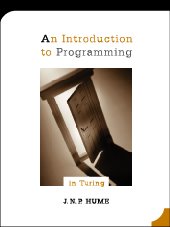Friday, September 22, 2006
more about Turing
The Turing programming language is named after Alan Turing, a British mathematician sometimes called "a father of modern computer science." Among his famous ideas are the Turing machine (2) and the Turing test . He also helped break German codes during World War II. There's a lot to say about him. A good place to start is the Wikipedia article on Turing at http://en.wikipedia.org/wiki/Alan_Turing.
The creators of the Turing programming language describe it as follows:
"The Turing programming language was developed at the University of Toronto as an ideal way to teach the concepts of Computer Science. Its straightforward syntax combined with easy-to-use graphics enables students to learn the fundamentals easily and enjoyably. Once programming concepts are mastered, switching to other languages such as Java or C++ is simply a matter of learning the new syntax. Turing is used by hundreds of schools to teach programming. Turing is available for both Windows 95/98/Me/NT/2000/XP and MacOS 7.1 and greater." Holt Software Home Page
The creators of the Turing programming language describe it as follows:
"The Turing programming language was developed at the University of Toronto as an ideal way to teach the concepts of Computer Science. Its straightforward syntax combined with easy-to-use graphics enables students to learn the fundamentals easily and enjoyably. Once programming concepts are mastered, switching to other languages such as Java or C++ is simply a matter of learning the new syntax. Turing is used by hundreds of schools to teach programming. Turing is available for both Windows 95/98/Me/NT/2000/XP and MacOS 7.1 and greater." Holt Software Home Page
Thursday, September 21, 2006
Where to get your copy of Turing
To practise programmingat home, you need a copy of the Turing program. Because of license restrictions, we can't give it away publicly through a Web link. However, the teacher will show you in class how to download a copy for your home computer.
We're studying the Turing programming language because it's simple
The text book we use is An Introduction to Programming in Turing by J.N.P. Hume (Holt Software Associates Inc.).

Students who are a little familiar with programming languages sometimes ask, "Why are we studying Turing? Why aren't we studying Java or C++ or C# or some other language?" There are a couple of good reasons for choosing Turing.
1. TURING IS SIMPLE TO LEARN
Turing is a good programming language to start with because it's one of the simplest languages to learn. For example, here's how to get Turing to show the words Hello, world! on the screen:
put "Hello, world!"
Simple, huh? The keyword put plus quotation marks around what you want to show on the screen. Neat! Now compare how much 'extra stuff' the language C++ needs to do the same thing:

#include
main()
{
cout << "Hello World!";
return 0;
}
Yikes, yuck! Look at that stuff - the #include, the angle brackets, the parentheses, the semi-colons, blah-blah-blah. With Turing you avoid all that.
So by learning Turing, you learn more more in less time with less pain.
2. TURING PREPARES YOU FOR OTHER LANGUAGES
In the coming years, many of you will go on to study Java or C++ or other languages. Is it a waste to start with Turing? No, not at all. Nearly everything you learn in Turing about variables, loops, selection, case statements, graphics, arrays, and so on is easily transferrable when you study another language.

Students who are a little familiar with programming languages sometimes ask, "Why are we studying Turing? Why aren't we studying Java or C++ or C# or some other language?" There are a couple of good reasons for choosing Turing.
1. TURING IS SIMPLE TO LEARN
Turing is a good programming language to start with because it's one of the simplest languages to learn. For example, here's how to get Turing to show the words Hello, world! on the screen:
put "Hello, world!"
Simple, huh? The keyword put plus quotation marks around what you want to show on the screen. Neat! Now compare how much 'extra stuff' the language C++ needs to do the same thing:

#include
main()
{
cout << "Hello World!";
return 0;
}
Yikes, yuck! Look at that stuff - the #include, the angle brackets, the parentheses, the semi-colons, blah-blah-blah. With Turing you avoid all that.
So by learning Turing, you learn more more in less time with less pain.
2. TURING PREPARES YOU FOR OTHER LANGUAGES
In the coming years, many of you will go on to study Java or C++ or other languages. Is it a waste to start with Turing? No, not at all. Nearly everything you learn in Turing about variables, loops, selection, case statements, graphics, arrays, and so on is easily transferrable when you study another language.